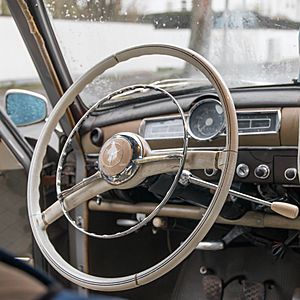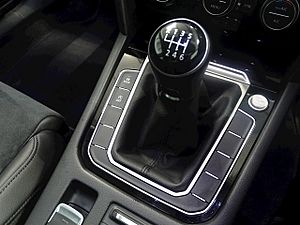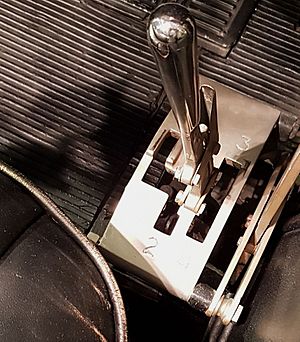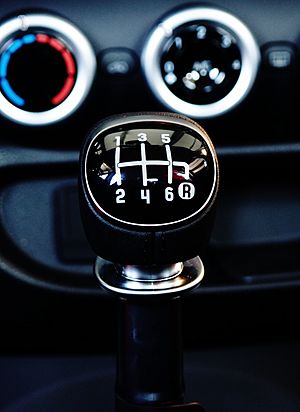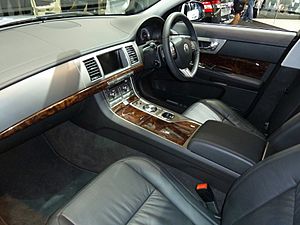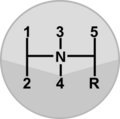Gear stick facts for kids
A gear stick (also called a gear lever or shifter) is a metal lever in a car that helps you change gears. It's connected to the car's transmission, which is like the car's gearbox.
When you drive a car with a manual transmission, you use the gear stick to select different gears. You also press the clutch pedal with your left foot. This temporarily disconnects the engine from the wheels so you can smoothly change gears. Cars with automatic transmissions have a similar lever called a gear selector. These cars don't have a clutch pedal because they change gears on their own.
Contents
Where You Find the Gear Stick
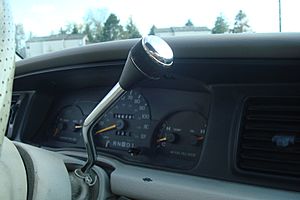
Most cars have the gear stick between the front seats. It might be on the center console or directly on the floor.
Some older cars and certain trucks have a column shift. This means the lever is on the steering column (the part that holds the steering wheel). In modern automatic cars, these levers often use electronic signals to change gears, rather than a direct mechanical link. This is called "shift-by-wire." Column shifters are still common in large North American pick-up trucks and emergency vehicles.
A few cars, like the old Citroën 2CV, had the shifter on the dashboard.
In some modern sports cars, the gear stick is gone completely! Instead, drivers use "paddles" behind the steering wheel. One paddle shifts up a gear, and the other shifts down. These paddles usually send electrical signals to the gearbox.
The Gear Knob and Its Features
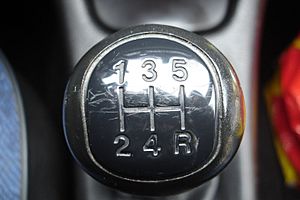
The top part of the gear stick that you hold is called the gear knob or shift knob. It usually has a diagram showing the shift pattern. This diagram tells you where to move the gear stick for each gear.
Sometimes, older manual cars had a switch on the knob to engage "overdrive." Overdrive helps the car save fuel at high speeds. In some automatic cars, the knob might have a switch for a "sports mode," which makes the car accelerate faster.
You might hear old terms like "three on the tree" for a manual shifter on the steering column with three forward speeds. A "four-on-the-floor" means a floor shifter with four forward speeds. If a car has a very low first gear, often used for heavy loads or steep hills, it's sometimes called a "granny gear."
For safety, new cars often require you to press the clutch pedal before the engine will start. This prevents the car from lurching forward or backward if it's accidentally left in gear.
Extra Gear Levers
Some traditional four-wheel drive vehicles have a second gear lever. This lever is used to engage a "low-ratio gearbox." This special gearbox helps the vehicle move slowly and powerfully over tough terrain, like mud or rocks.
There might also be another lever called a transfer case lever. This one switches between two-wheel drive and four-wheel drive. It can also lock the differentials, which helps all wheels get power evenly. These are not exactly "gear levers" but are often next to the main one.
Understanding Shift Patterns
The shift pattern shows how the gears are arranged on the gear stick. In most manual cars, first gear is usually to the left and forward. There's often a spring that brings the stick back to a central "neutral" position. Reverse gear is usually placed in a way that prevents you from accidentally selecting it while driving forward.
Manual Transmission Patterns
A typical manual car with five forward gears will have seven possible positions: five for forward gears, one for reverse, and a central "neutral" position. Many cars have special ways to prevent accidentally selecting reverse, like needing to lift, push down, or use extra force on the lever.
| Layout | Description |
|---|---|
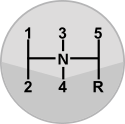 |
This is the most common five-speed shift pattern. It's easy to understand, moving from left to right and top to bottom. Reverse is usually at the end. |
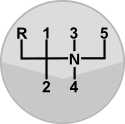 |
This is another common five-speed pattern, found in cars like Saabs and BMWs. Reverse gear is often placed here to prevent you from accidentally selecting it while the car is moving. |
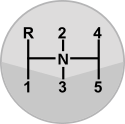 |
This pattern is called a "dog leg" because of the angled path between first and second gears. It's often used in race cars and some older sports cars. First gear is usually only for starting the car, so having second and third gears in a straight line makes shifting between them faster. |
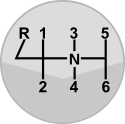 |
This is a typical pattern for a six-speed transmission. Six speeds are common in cars. Large trucks can have many more gears (8, 16, or even 20!) using special multi-range gearboxes. |
 |
This is a shift pattern for a 4-speed car. It was also found in some older cars with column shifters. |
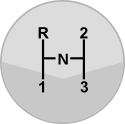 |
This is a shift pattern for a 3-speed car. |
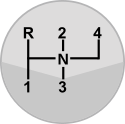 |
This is a shift pattern for a 4-speed column shifter, found in some older cars like the Peugeot 403. |
Automatic Transmission Patterns
Automatic transmissions usually have a straight shift pattern, often labeled P-R-N-D:
- P = Park - The transmission is locked, so the car won't roll.
- R = Reverse - For moving backward.
- N = Neutral - The engine is running, but no power goes to the wheels.
- D = Drive - For normal forward driving, where the car automatically shifts through all gears.
Many automatic cars also have numbered positions below "Drive," like P-R-N-D-3-2-1. These allow you to limit the highest gear the car will use. For example, selecting "2" means the car won't shift higher than second gear. Some cars use "L" (for "low") instead, which keeps the car in a lower gear for climbing steep hills or strong acceleration.
Some modern automatic transmissions use a "J-gate" pattern, where the stick moves sideways as well as forward and backward. Others, like "manumatics" (e.g., Porsche Tiptronic), have a regular automatic pattern plus a special section where you can push the stick forward or backward to manually shift gears up or down. This can be helpful in snowy conditions.
Electronic Gear Shifts
With newer "shift-by-wire" systems, the gear stick doesn't need a physical connection to the transmission. This means designers can make the shifter much smaller. Sometimes, the gear stick is replaced entirely by buttons, rotary knobs (like in some Jaguar and Land Rover models), or a tiny lever on the center console. This technology was even used in some cars in the 1950s!
Special Gear Knobs
A shift knob is the part you hold to change gears. They come in many shapes, sizes, and materials, from simple plastic to fancy designs. Car manufacturers often make them round, like a chess pawn.
The main job of the shift knob is to make it comfortable and easy for the driver to change gears. The gear stick itself is often just a metal rod, and the knob fits on its end.
In recent years, car companies and aftermarket shops offer many different shift knobs. Some are just for looks, while others are designed to improve shifting performance.
Weighted Shift Knobs
A weighted shift knob is a special type of knob that is heavier than a normal one, usually between 400 and 600 grams. It's often used with a "short shifter," which reduces the distance the gear stick moves. The idea is that the extra weight makes the gear stick top-heavy. This increases the momentum when you shift, helping you change gears faster and more smoothly.
Images for kids
See also
 In Spanish: Palanca de cambios (automóvil) para niños
In Spanish: Palanca de cambios (automóvil) para niños


